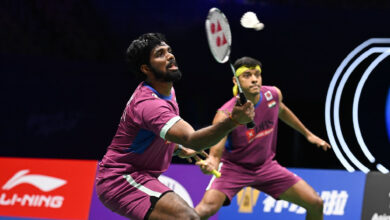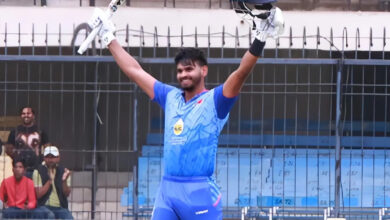Border-Gavaskar Trophy: Kotla pitch ready to test spin-wary Australians again

The yellow mower whirred into life under the Kotla sun, durbing the siesta of the groundsmen sprawled beside a set of broken chairs in the stands. As though a siren had wailed, they sprung into action, holding flat-faced, rust-eaten hammers and brooms with long sharp teeth. A burly man in a light brown half-sleeved sweater would angrily bark out instructions, and soon they were engaged in a blur of brisk activities.
Then they suddenly paused, as though the siren wailed again. It was then that Australia’s coach Andrew McDonald and an army of support staff hustled onto the ground, to take one last look at the pitch, the characterics of it dwelling in their minds ever since they landed in the country. Like a bunch of wizened sleuths desperate to unearth clues at a murder site cordoned off in yellow and black tape, they inspected the 22-yard strip with a forensic eye for detail. McDonald would lean and inspect a bare patch on the good-length area. Another moved his fingers through the brown-grass-specked spots in the middle of the surface. Then the group broke into a huddle beside the practice pitch, perhaps to discuss and analyse their findings. Then they hastily disappeared into the dressing room.
The other day, the groundstaff were secretive, disallowing the Australian media to click pictures. But on Wednesday, the pitch was unravelled for public display. What met their eyes was a characteric Kotla surface, bald and chestnut brown, with barely a speck of grass on the good-length area. There were discoloured blotches of dark brown, like a healing scratch on the skin. Flicker the eyes to the middle of the pitch, a stubble of unkempt grass would greet them, dead, hollow grass as though scorched the sun, which foretold the fast-ushering summer days. There was hardly any dust though, even when the broom gnashed its big bare teeth. After the Australian inquisitors left, the groundsmen had a chuckle about something before the burly man began to belt out instructions and they resumed their grooming.
Groundmen cover the main pitch at the Ferozshah Kotla Stadium in New Delhi. (Express photo: Praveen Khanna)
It’s the dryness that struck the eyes of Mitchell Starc. “It looks pretty dry. The groundsman said the nets look pretty similar and the two days we trained on were really low and took a lot of turn,” the left-arm paceman said. “If that’s an indication, that’s what it’s going to be like,” he added.
In the morning, almost everyone would drop and prostrate, as though to offer prayers like the devout would on Thursday evening at the Kotla fort to propitiate the djinns. The Nagpur unravelling was not entirely pitch-provoked, but the pitch clearly seems to haunt the Aussies like the unchained djinns of the Kotla fort. At the nets, Travis Head asked a local net bowler about the nature of the turn. “You’ve played here, what do you think?” The wiry teenager would dead-bat: “No sir, I have not.” Head would not relent: “The bounce here?” He would politely reply: “Good bounce, sir.”
Past hory
The Australians would have definitely tapped into information about the surface and scoured footage of previous games. Some of them, like Steve Smith and Nathan Lyon, have played here too, though a decade ago. But they would know that the Kotla horically has been a slow-turner until the back end of the game, wherein invariable bounce kicks in, a trusted ally of Kotla-wrecker Anil Kumble (58 wickets at 16.79). Games tend to go deeper than at most other venues. The last Test here was a slow-burning thriller amid unbreathable conditions as Sri Lanka mustered a draw in the final session. Even the supposed turner against South Africa did not turn out to be vicious, as Hashim Amla and AB de Villiers channelled their inner stonewallers in a marathon blockathon. De Villiers blocked for 354 minutes for 43, the eleventh slowest innings of all time. Amla hung around for 289 minutes for 25 runs, the 14th slowest knock of all time.
Just one of the nine Tests this century has not seen the fifth day, but that featured Australia. It was a bouncier surface with sharp turn, much to the relish of Ravindra Jadeja, who grabbed five in the second innings. Nathan Lyon nabbed nine in the game too. But there is only so much one could glean from hory when preparing for a Test. Curators could be alchems who could alter the characterics of the surface. A bit more watering, a bit less watering, less exposure to sun, more sun-lighting, all could determine how a deck behaves or misbehaves. Elements like sunlight, rain, moure, water table, which could vary every season, and changing properties of the soil, could impact how a pitch looks and behaves.
India coach Rahul Dravid would later say: “We do check the hory of grounds and the numbers, but every game is different, we play against a different team, different individuals. So we just can’t rely on hory and be confident of winning the game.”
Variable bounce
One trait of the Kotla the Australian batsmen have picked from hory, experience and perhaps local input is the variable bounce in the surface. In the nets, bowling coach Daniel Vettori was asked to bowl his under-cutters that skid along the surface. A tall local net bowler with a high-arm action would be asked to bowl in tandem, so that they get used to the vicissitudes of variable bounce. For almost the entire session, Australia’s army of left-handed batsmen fed on spin-diet. Even part-timers chimed in, from the floaty off-spin of Usman Khawaja, who has bowled merely 29 overs in his first-class career, to Steve Smith going back in time to the 2013 series wherein he was picked as a leg-spinning all-rounder (and almost broke his nose but for his quick hands that diverted a clump from Head), and even Pat Cummins who bowled off-spin with a highly-suspicious bent elbow.
Whoever bowled in the practice nets, the surface seemingly abrasive, found ripping turn. Perhaps, that’s what the Australian batsmen wanted too — a stiff examination of their technique before the Kotla interrogation, a feeler of the centre pitch, which shone under the Kotla sun, blazing in its pre-summer fury.







